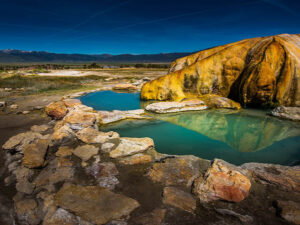hot spring
A hot spring is a natural phenomenon where groundwater is heated by geothermal energy and rises to the surface, creating a pool of hot water. These springs occur in areas with geologically active features such as volcanic regions or tectonic plate boundaries. Here are some key details about hot springs:
Formation: Hot springs are formed when groundwater seeps into the Earth’s crust and comes into contact with hot rocks or magma chambers deep underground. The heat from the Earth’s interior warms the water, which then rises back to the surface, often through cracks or fissures in the ground.
Temperature: Hot springs are characterized by their elevated temperature compared to the surrounding environment. The temperature of hot springs can vary widely, ranging from pleasantly warm to scalding hot. The temperature is influenced by factors such as the depth of the water source and the amount of heat generated by geothermal activity.
Mineral Content: Hot springs are often rich in dissolved minerals due to the interaction between the heated water and the surrounding rocks. The mineral content can give the water a distinct taste and color. Some hot springs are renowned for their high mineral concentration, which is believed to have various health benefits such as improving skin conditions and promoting relaxation.
Uses and Benefits: Hot springs have been enjoyed by people for centuries due to their therapeutic properties. Soaking in hot spring water can help relieve muscle tension, improve blood circulation, and reduce stress. The minerals in the water are also thought to have healing properties for certain ailments. Many hot springs are developed into resorts or wellness centers where visitors can enjoy bathing, spa treatments, and other relaxation activities.
Cultural and Recreational Significance: Hot springs hold cultural significance in many societies around the world. They are often considered sacred or spiritual places and have been used for rituals, purification ceremonies, and communal bathing. In addition to their cultural importance, hot springs are popular recreational destinations where people can relax, unwind, and connect with nature.
Locations: Hot springs can be found in various countries across the globe. Some well-known hot spring destinations include Yellowstone National Park in the United States, the Blue Lagoon in Iceland, the onsens of Japan, and the geothermal areas of Rotorua in New Zealand. However, hot springs can also be discovered in less-known or off-the-beaten-path locations, offering a unique and tranquil experience.
When visiting a hot spring, it’s important to respect the natural environment and adhere to any rules or guidelines provided at the site. It’s also recommended to check the water temperature before entering and be cautious of any potential hazards or risks associated with the specific hot spring you are visiting.
Whether you seek relaxation, therapeutic benefits, or a connection with nature, hot springs provide a soothing and rejuvenating experience for many visitors.
